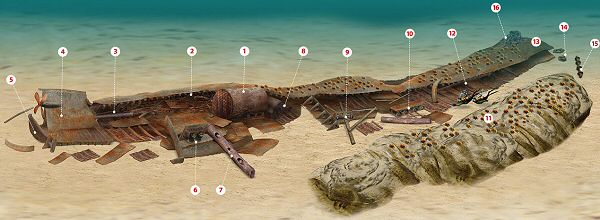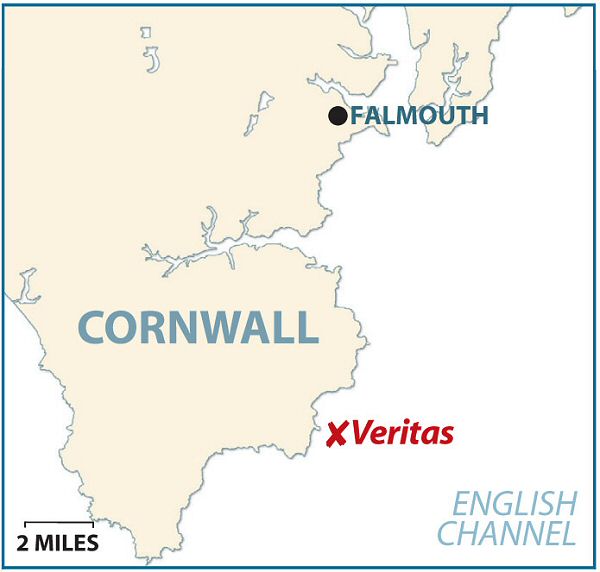A slightly deeper dive than usual for Cornwall’s infamous Manacles reef, this old Norwegian freighter wreck is worth a visit, says JOHN LIDDIARD. Illustration by MAX ELLIS
THIS MONTH’S TOUR IS A NICE little wreck a mile or so south of the Manacles. At 672 tons, the Veritas is considerably smaller and, at 38m, a little bit deeper than the usual slackwater dive that is the Mohegan (Wreck Tour 8), but it’s well worth a look.
On an echo-sounder, the parts that show best are the boiler and the stern. To decide which to shot from the boat, the boiler is a little further north, and that’s where our tour begins (1), at a depth of 35m.
The Veritas sank well over on its starboard side. The hull then collapsed and the deck fell outwards. Over the aft part of the wreck, the port side of the hull (2) is held up by the boiler, with a nice little overhang beneath it.
Most of the overhang is full of debris, including the remains of the triple-expansion engine, but this is pretty much buried. As you get closer to the stern, a section of propeller-shaft (3) is visible right down in the keel.
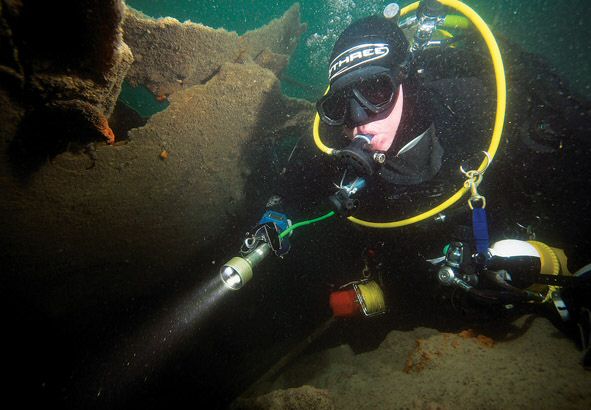
The stern (4) has fallen completely upside-down, with the keel and four-bladed propeller standing some 4m clear of the seabed. This is actually only a short distance from the boiler because, at 72m long, the Veritas was quite a small ship.
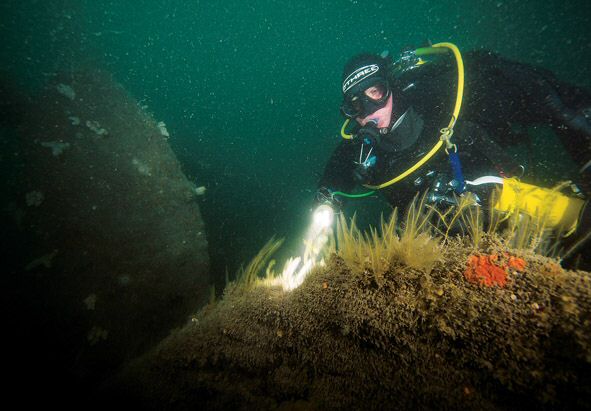
Beneath the stern, the rudder (5) has fallen and lies across the wreck, with the remains of the steering mechanism at the top of the post.
Our route forwards now follows the deck off the starboard side along the seabed at 38m. About halfway back to the boiler is a section of hold-coaming, and immediately next to this is a cargo-winch tipped up on one end (6). The corresponding mast (7) lies perpendicular to the line of the wreck out onto the sand.
Now back at the boiler, a smaller donkey boiler (8) runs across the wreck just forward of the main one.
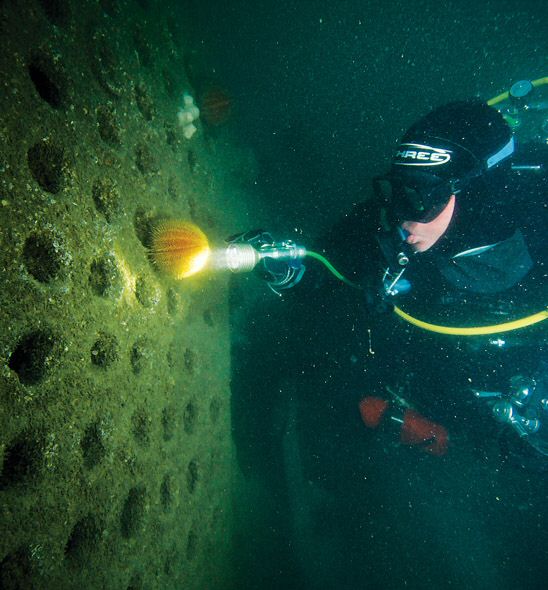
The forward half of the wreck is much closer to the seabed, quite understandable as the bow of the Veritas was dug in for two days while the vessel stood on end. It swayed with the tide before finally sinking, the stern kept afloat by trapped air and the cargo of wooden pit-props.
Or perhaps a lot of the collapse was caused by a failed salvage attempt.
Soon after the sinking, the salvage company that had been working on the battleship Montague off Lundy Island tried to move the Veritas into shallow water using strops and lighters, but ended up not moving it at all.
Just forward from the donkey boiler, a large braced section of hull and deck lies out from the wreck.
Tucked in behind this, beneath a couple of deck ribs, is the helm (9).
Continuing forward towards the edge of the wreck, the two cargo-winches serving the forward holds are together beneath their deck-plate (10), the corresponding mast pointing out towards a small reef just away from the wreck (11).
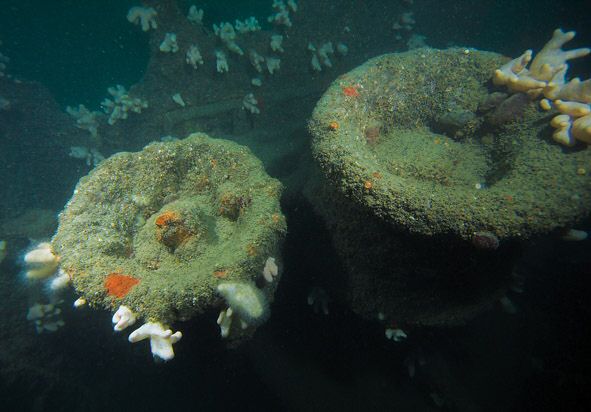
The wreck further forwards is more compact, with the two sides of the hull lying pretty much on top of each other (12). The clean plates of the port side are home to a respectable forest of pink seafans, as is the nearby reef.
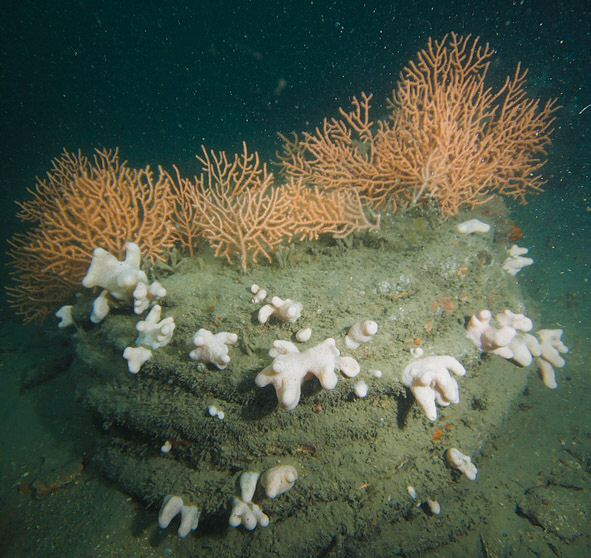
“Pink” is the official name, but to me they have always seemed more of a biscuit colour. I admire the way they are all perfectly lined up east-west across the current. If a diver should become disoriented in low visibility, this could be of help with navigation.
The forest of fans continues all the way to the bow (13). This is completely collapsed, with the iron ring from an anchor hawse pipe lying separated on the seabed alongside a reel of mooring cable (14). The spindles of the anchor-winch (15) lie broken a little further out.
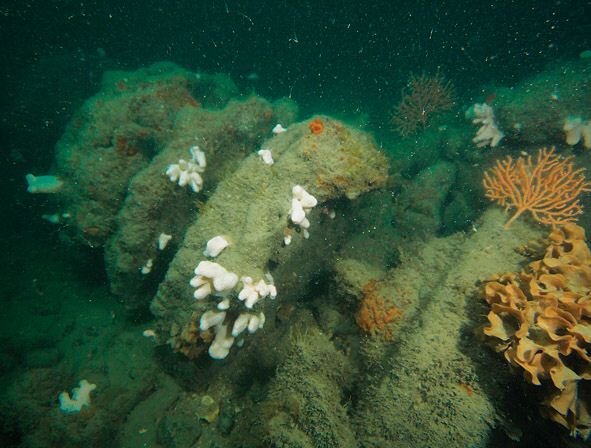
Back on the wreckage, our tour concludes by following the stem of the bow round to the keel, where a mass of anchor-chain has burst through the hull from the chain-box (16).
On such a small wreck in good visibility, it shouldn’t be that hard to find the way back to the shotline to ascend, but only if there is not too much decompression accumulated.
With longer stops to complete, an ascent on a delayed SMB will be much more comfortable as the tide picks up.
VERITAS, cargo steamship. Built unknown, SUNK 1907
The first repairs to the hull of the 672-ton Norwegian steamship Veritas of Bergen were carried out – badly – in Portland Harbour, writes Kendall McDonald.
The Veritas was coming from Norway to South Wales at the end of October 1907 when she collided with another steamer in the Channel, a hard hit that caused her to take in water, and sent her into Portland with several leaks.
Captain Tollefsen knew he had come off badly in the collision, but didn’t seem to take as much care about checking the repairs as he should have done. He sailed again for Wales with his cargo of pit wood on 4 August, and seems to have relied on the temporary repairs to get him there.
But he had only reached the Lizard when the sea started coming in again. This time, the leak was persistent. Then, suddenly, it turned into a flood.
The pumps on the Veritas couldn’t cope, and soon the boiler fires hissed into wet ashes.
Captain Tollefsen ordered both anchors dropped, and followed this with a cry of: “Abandon ship!” The captain, his wife and his crew of 14 men moved swiftly into the boats and rowed into Coverack.
Soon three Falmouth tugs, the Triton, Eagle and Dragon, were on the way, but once at the stricken ship they found that the anchors were down, and without steam power there was no way they could be released.
Finally, the salvagemen unshackled the anchor cables and started to tow the ship to Coverack, but before they got there the Veritas lifted her stern high in the air and her bow crashed down to the seabed. For two days she remained in this vertical position, before foundering sternfirst and rolling upside-down.
Another attempt to bring her into shallow water was made by the salvage steamer Etna, which was brought to the scene from Lundy where she had been salvaging HMS Montague, but despite using pontoons and lighters, the wreck was abandoned.
Divers will be interested to note that one of the wreck’s owners from 1969 to 1991 was author and wreck expert Richard Larn (see Tour Guide below).
TOUR GUIDE
GETTING THERE: Follow the M5 to Exeter, then the A30 and A3076 to Truro, and the A39 to Falmouth. For the closest launch sites just before Falmouth follow the A394 to Helston, then take the A3083 towards Lizard Point and turn left onto the B3293 to St Keverne immediately after passing RNAS Culdrose. From the square in St Keverne, turn left for Porthkerris or go straight across for Porthoustock.
HOW TO FIND IT: The GPS co-ordinates are 50 00.700N, 05 04.894W (degrees, minutes and decimals). The Veritas lies with the bow to the north. The boiler and stern stand far enough from the seabed for a good echo.
TIDES: Slack water is essential, and occurs one to two hours after high water and low water Falmouth.
DIVING & AIR: Porthkerris Dive Centre runs a number of dive-boats and can assist with beach-launching of club RIBs, 01326 280620.
DIVING : Our W, Dive-125, 07764 585353.
AIR : Our W has an onboard compressor and a limited supply of oxygen for mixing nitrox. If you require large quantities of oxygen or any helium, it is best to arrange it in advance. The nearest commercial air station is Newhaven Scuba Centre, 01273 612012.
ACCOMMODATION: There are many static caravan sites on the Lizard, and these can be particularly good value for money. Falmouth Tourist Information Centre, 01326 312300, visit Cornwall.
QUALIFICATIONS: Depth places the Veritas a little bit deep for PADI unless you have a deep speciality. For BSAC divers, this one is Dive Leader or above.
LAUNCHING: The nearest slip is at Falmouth. Beach-launching is possible over shingle beaches at Porthkerris and Porthoustock. At Porthkerris you will need assistance from the dive centre’s tractor to survive the shingle. Porthoustock beach is just passable for a 4×4 if the driver is careful. Further south, it is possible to launch across the sand at Kennack.
FURTHER INFORMATION: Admiralty Chart 154, Approaches to Falmouth. Ordnance Survey Map 204, Truro, Falmouth & Surrounding Area. Diver Guide – Dive South Cornwall by Richard Larn. Shipwreck Index of the British Isles, Vol 1, by Richard & Bridget Larn. Many of the local pubs have historical photographs and wreck memorabilia on the wall. Particularly worth checking out are the Five Pilchards in Porthallow and the Three Tuns in St Keverne.
PROS: Something different from the usual Manacles dives. Fairly easy as deeper dives go, as long as you get slack water right.
CONS: A bit deep compared to other wrecks and reefs in the area.
DEPTH RANGE: 35-45m
Thanks to Andy Howell, Mike Anselmi and Kevin Heath.
Appeared in DIVER January 2010
